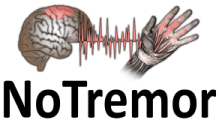NoTremor Developed for Parkinson’s Disease Computer Simulation, Analysis, Treatment

 NoTremor, a Parkinson’s disease research project funded by the European Union, is working on developing patient specific computational models of the brain and neuromuscular systems that can be used to improve the quality of Parkinsons disease (PD) analysis and progression monitoring. In particular, the NoTremor team of researchers aims to establish a link between brain modeling and neuromuscular systems and provide a holistic representation of PD physiology for patients.
NoTremor, a Parkinson’s disease research project funded by the European Union, is working on developing patient specific computational models of the brain and neuromuscular systems that can be used to improve the quality of Parkinsons disease (PD) analysis and progression monitoring. In particular, the NoTremor team of researchers aims to establish a link between brain modeling and neuromuscular systems and provide a holistic representation of PD physiology for patients.
The 36-month project launched as “NoTremor – Virtual, Physiological and Computational Neuromuscular Models for the Predictive Treatment of Parkinsons Disease,” on January 1, 2014.
NoTremor investigators are working to integrate computational models of the basal ganglia and brainstem into a multi-scale parametric computational model that can be later simulated in the NoTremor simulation engine. A special visual analytics interface will be provided to health professionals to support hypothesis testing and visual inspection of the simulation.
Simply, the models aim to link midbrain degenerations to motor behaviors in order to estimate an individual’s internal midbrain state and observe motor abilities. Scientists will be able to monitor disease progression precisely, track the effect of medication, and then match medications with improved accuracy according to the disease stage.
The ultimate challenge for the NoTremor developers will be investigation, virtual prototyping’ and testing using virtual patient models. Project leaders maintain that NoTremor will revolutionize the pathophysiology of neurodegenerative movement disorders research.
The computational models will be quantified and validated through clinical trials involving large PD patient cohorts.
Parkinson’s disease, a multifaceted condition with both motor and non-motor symptoms, is currently the second most common neurodegenerative disorder after Alzheimer’s disease, and is expected to impose an increasing social and economic burden on societies coping with the current dynamic of aging population demographics.
According to the European Parkinson’s Disease Association, 1.2 million people in Europe currently have PD, and the numbers are expected to grow significantly as the baby boomer generation grows older.
Projected increases of PD prescription drugs and patient care costs vary, but according to Parkinson’s UK, the overall cost in the U.K. is estimated to range between £449 million and £3.3 billion annually, or higher when indirect costs from lost productivity and caregiver burden are factored.
The NoTremor investigative team affirms that their objective is to meet future challenge by revolutionizing the way Parkinson’s disease is treated.
Model validation will be conducted based on correspondence between virtual and real patient behavior. The model will be used to increase understanding of future patient behavior and diagnosis of internal pathological state. The ultimate aim is to minimize future therapy costs, while also significantly enhancing treatment effectiveness.
The NoTremor project’s specific objectives are:
1) Provision of novel patient-specific parametric computational models
2) Coupled cognitive-motor simulation engine
3) Inverse simulation for clinical state assessment and progress monitoring
4) Analytics and new metrics for simulated evaluation and monitoring of medical treatment
5) Test campaigns with beneficiaries
VPH 2016 Satellite Workshop: Multi-Scale Modeling and Simulation and Analytics for Parkinson’s Disease
 NoTremor will be organizing a Satellite Workshop on Tuesday September 27, 2016 from 16:00-18:00 during the VPH 2016 conference at the Royal Tropical Institute in Amsterdam, The Netherlands. The event, “Multi-Scale Modeling and Simulation and Analytics for Parkinsons disease,” will highlight new ideas, achievements and implementations in the PD computational modeling field. Discussions will include the latest scientific and technical outcomes of the NoTremor project.
NoTremor will be organizing a Satellite Workshop on Tuesday September 27, 2016 from 16:00-18:00 during the VPH 2016 conference at the Royal Tropical Institute in Amsterdam, The Netherlands. The event, “Multi-Scale Modeling and Simulation and Analytics for Parkinsons disease,” will highlight new ideas, achievements and implementations in the PD computational modeling field. Discussions will include the latest scientific and technical outcomes of the NoTremor project.
Some topics include:
• Brain modeling and simulation for PD at all scales of analysis: from neural membranes to systems
• Neuromuscular simulation and its interaction with brain modelling
• Modelling of motor control
• Subcortical LFP modelling
• Clinical assessment (typically performed for neurological disorders such as Parkinson’s disease)
• New ICT measurement techniques (e.g. oculometry, biomechanical movements, latencies, dynamics)
• Simulation platforms
• Information visualization and visual analytics for PD
For more information, visit
https://vph-conference.org/program/detailed-program/tuesday/satellite3/






